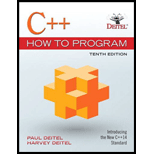
C++ How to Program (Early Objects Version)
10th Edition
ISBN: 9780134448824
Author: Paul Deitel; Harvey M. Deitel
Publisher: Pearson Education (US)
expand_more
expand_more
format_list_bulleted
Concept explainers
Expert Solution & Answer
Want to see the full answer?
Check out a sample textbook solution
Students have asked these similar questions
answer shoul avoid using AI and should be basic and please explain
Node A is connected to node B by a 2000km fiber link having a bandwidth of 100Mbps.
What is the total latency time (transmit + propagation) required to transmit a 4000 byte file using packets that include
1000 Bytes of data plus 40 Bytes of header.
answer should avoid using AI and should be basic and explain please
Chapter 11 Solutions
C++ How to Program (Early Objects Version)
Ch. 11 - Exercises11.3 (Composition as an Alternative to...Ch. 11 - (Inheritance Advantage) Discuss the ways in which...Ch. 11 - (Protected vs. Private Base Classes) Some...Ch. 11 - Prob. 11.6ECh. 11 - Prob. 11.7ECh. 11 - (Quadrilateral Inheritance Hierarchy) Draw an...Ch. 11 - Package Inheritance Hierarchy} Package-delivery...Ch. 11 - (Account Inheritance Hierarchy) Create an...
Knowledge Booster
Learn more about
Need a deep-dive on the concept behind this application? Look no further. Learn more about this topic, computer-science and related others by exploring similar questions and additional content below.Similar questions
- answer should avoid using AI (such as ChatGPT), do not any answer directly copied from AI would and explain codearrow_forwardanswer should avoid using AI (such as ChatGPT), do not any answer directly copied from AI would and explain codearrow_forwardWrite a c++ program that will count from 1 to 10 by 1. The default output should be: 1, 2, 3, 4, 5, 6 , 7, 8, 9, 10 There should be only a newline after the last number. Each number except the last should be followed by a comma and a space. To make your program more functional, you should parse command line arguments and change behavior based on their values. Argument Parameter Action -f, --first yes, an integer Change place you start counting -l, --last yes, an integer Change place you end counting -s, --skip optional, an integer, 1 if not specified Change the amount you add to the counter each iteration -h, —help none Print a help message including these instructions. -j, --joke none Tell a number based joke. So, if your program is called counter, counter -f 10 --last 4 --skip 2 should produce 10, 8, 6, 4 Please use the last supplied argument. If your code is called counter, counter -f 4 -f 5 -f 6 should count from 6. You should…arrow_forward
arrow_back_ios
SEE MORE QUESTIONS
arrow_forward_ios
Recommended textbooks for you
 C++ Programming: From Problem Analysis to Program...Computer ScienceISBN:9781337102087Author:D. S. MalikPublisher:Cengage Learning
C++ Programming: From Problem Analysis to Program...Computer ScienceISBN:9781337102087Author:D. S. MalikPublisher:Cengage Learning C++ for Engineers and ScientistsComputer ScienceISBN:9781133187844Author:Bronson, Gary J.Publisher:Course Technology Ptr
C++ for Engineers and ScientistsComputer ScienceISBN:9781133187844Author:Bronson, Gary J.Publisher:Course Technology Ptr Microsoft Visual C#Computer ScienceISBN:9781337102100Author:Joyce, Farrell.Publisher:Cengage Learning,
Microsoft Visual C#Computer ScienceISBN:9781337102100Author:Joyce, Farrell.Publisher:Cengage Learning, EBK JAVA PROGRAMMINGComputer ScienceISBN:9781337671385Author:FARRELLPublisher:CENGAGE LEARNING - CONSIGNMENT
EBK JAVA PROGRAMMINGComputer ScienceISBN:9781337671385Author:FARRELLPublisher:CENGAGE LEARNING - CONSIGNMENT Systems ArchitectureComputer ScienceISBN:9781305080195Author:Stephen D. BurdPublisher:Cengage LearningProgramming Logic & Design ComprehensiveComputer ScienceISBN:9781337669405Author:FARRELLPublisher:Cengage
Systems ArchitectureComputer ScienceISBN:9781305080195Author:Stephen D. BurdPublisher:Cengage LearningProgramming Logic & Design ComprehensiveComputer ScienceISBN:9781337669405Author:FARRELLPublisher:Cengage

C++ Programming: From Problem Analysis to Program...
Computer Science
ISBN:9781337102087
Author:D. S. Malik
Publisher:Cengage Learning

C++ for Engineers and Scientists
Computer Science
ISBN:9781133187844
Author:Bronson, Gary J.
Publisher:Course Technology Ptr

Microsoft Visual C#
Computer Science
ISBN:9781337102100
Author:Joyce, Farrell.
Publisher:Cengage Learning,

EBK JAVA PROGRAMMING
Computer Science
ISBN:9781337671385
Author:FARRELL
Publisher:CENGAGE LEARNING - CONSIGNMENT

Systems Architecture
Computer Science
ISBN:9781305080195
Author:Stephen D. Burd
Publisher:Cengage Learning

Programming Logic & Design Comprehensive
Computer Science
ISBN:9781337669405
Author:FARRELL
Publisher:Cengage
What is Abstract Data Types(ADT) in Data Structures ? | with Example; Author: Simple Snippets;https://www.youtube.com/watch?v=n0e27Cpc88E;License: Standard YouTube License, CC-BY